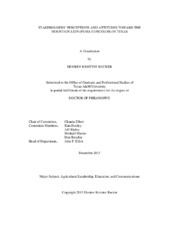| dc.description.abstract | The Texas mountain lion (Puma concolor) is found throughout the Trans-Pecos, as well as in the brush lands of South Texas. Though recent, continuing studies suggest the Texas mountain lion population is stable, hunters of the mountain lion have no limitations of season, number of animals, or methods used for harvest. There are no defined harvest management goals or strategies for the Texas mountain lion. The objective of this qualitative study was to define attitudes, perceptions, and values of hunters and wildlife biologists towards the mountain lion while developing an understanding of hunter and wildlife biologist engagement in mountain lion management. Purposive sampling was based on specific criteria of documented experience with the mountain lion in its natural habitat. Data was collected through a focus group, individual interviews, observational data, and archival data. Peer debriefing, audio taping, and use of case study protocol established trustworthiness.
Five main themes resulted from this inquiry. They were (a) value, (b) management, (c) knowledge, (d) profit, and (e) history. The most notable theme, value, was expressed as the mountain lions’ benefit to the community, lifestyle, and the experience of encountering the mountain lion. Both hunters and wildlife biologists supported the continued existence of the mountain lion for the hunting experience and personal satisfaction. The most unanticipated theme is lack of knowledge and reliable reporting methods. Though there remains a negative perception of hunting, hunters have a positive attitude toward the Texas mountain lion and engaging community members. Wildlife biologists have a positive attitude toward engaging the public in implementing a mountain lion management strategy. Common purposes were identified and described that may possibly be the foundation for future collaboration efforts and leadership training. Leaders among both hunters and wildlife biologists who are committed to collaborating and becoming change agents should be identified. Leaders should be trained to act as agents of change that are able to influence design and implementation of mountain lion management strategies that are accepted, effective, and sustainable. | en |


